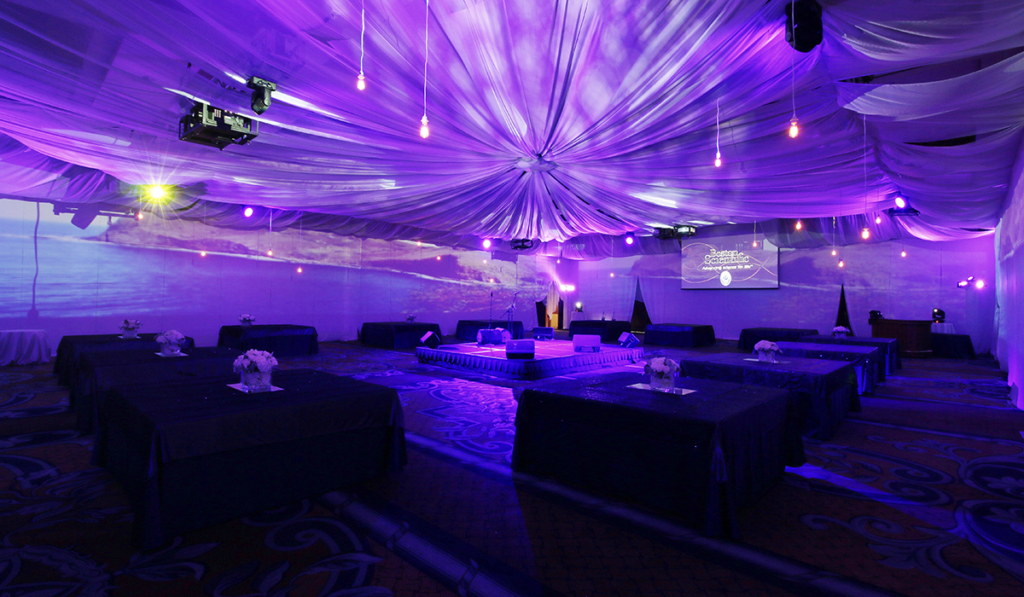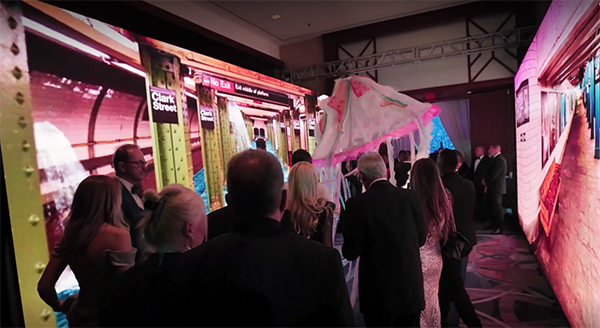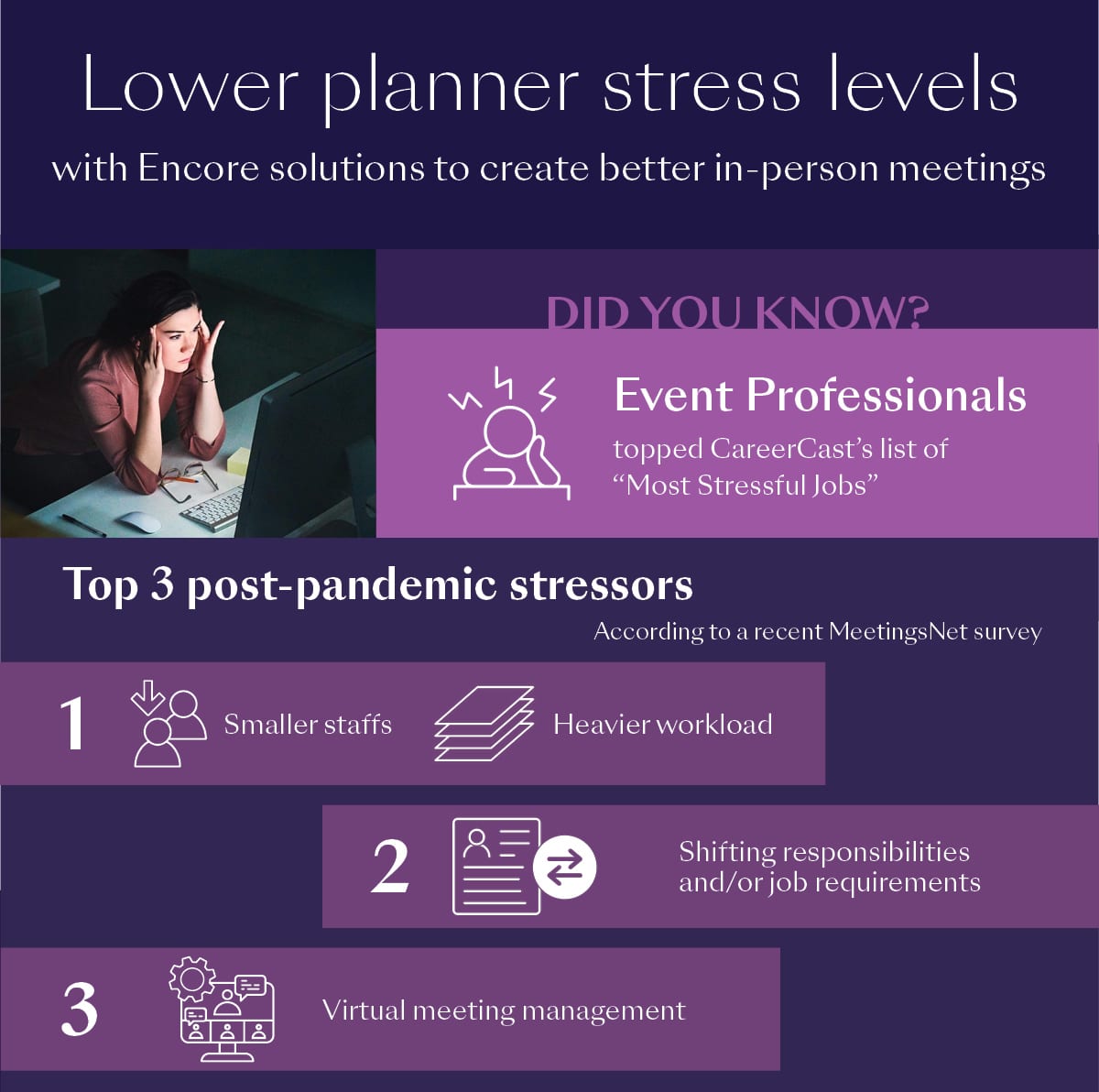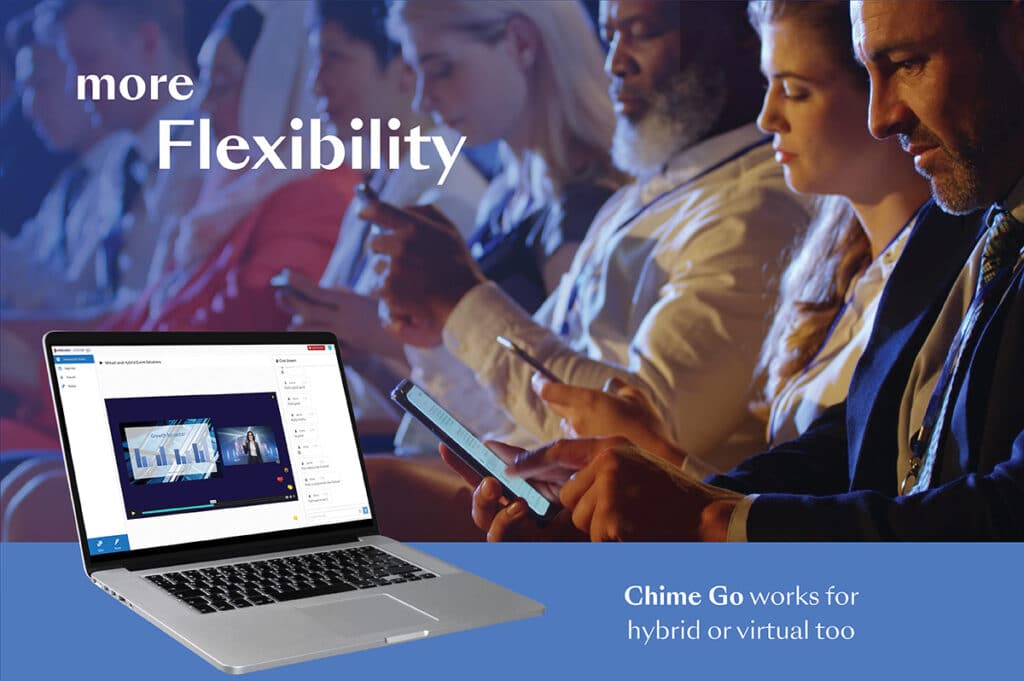How to leverage color psychology to
Unlock the Unforgettable
Colors play a vital role in helping us navigate the world around us. Certain hues can influence how we feel, behave and even respond in various settings, giving them an intriguing role in human psychology and fueling our long-held fascination with them.
This year, Pantone, the industry leader in color forecasting, declared the vibrant Viva Magenta as the Color of 2023. Described by the institute as “bold” and “unapologetic,” this shade was chosen to evoke a sense of confidence and optimism in the post-pandemic world.

*Photo caption: Courtesy of ARTECHOUSE
Each year’s color is carefully selected based on current trends, social and political events and global attitudes. Once announced, it becomes a symbol of the times, evoking emotions and memories specific to that moment.
In our industry, for example, we’re seeing the sense of optimism that Viva Magenta is meant to signify with the surge of in-person events — which are expected to continue increasing. This hopeful sentiment is reflected by audiences who have shown their desire for the return of face-to-face interactions.
In a number of other business sectors, ranging from fashion to marketing, the color of the year is used to forecast trends in branding and design, product development and purchasing decisions. It’s become so influential that the 2024 color of the year has already been selected (Apricot Crush), and there are predictions for which hue will hold the glory in 2025 (Future Dusk)! But what grants a singular shade such power?
Read on to explore the impact of color psychology and how to leverage it to promote certain mindsets, further engagement and participant learning, and deliver an inspiring attendee experience at your next meeting or event.
Color psychology: Why certain hues affect
our moods
Colors are not just a matter of aesthetics; they can have a profound impact on our mental state. Research in this area has confirmed what we have long suspected: that colors can influence our internal physiology and create unconscious reactions.
Consider the neurological effects of warm versus cool tones. Bright and warm colors, like red, orange and yellow, stimulate our senses and can evoke feelings of happiness, optimism and energy. Contrastingly, cool and calm tones like blues and greens are typically internalized as soothing.
“When people are in an environment that has a fair amount of red accent light, their pulse rate increases slightly and they tend to breathe a little bit faster, which actually equates to them being able to think more analytically. This means that they are able to crunch numerical data better than in say a blue room which has the converse effect.”
— Tom Drozd, Product Manager at Encore
The sway color has on our mindset and behavior has become so renowned, in fact, that prisons have even used a specific shade of pink, known as “drunk tank pink,” in efforts to calm violent prisoners.

This fascinating field of research shows us that, not only does the presence of color affect our cognition and mood, certain hues affect how we internalize information and interact.
How color enhances participant learning and the event experience
Humans are more sensitive to the impact of color than you may expect, something that grants you a unique capability to strategically influence audiences. How? By leveraging this aspect of your meeting or event design, you can boost engagement and participant learning to strengthen the power of your programming.
“There has been a lot of research dedicated towards neuroscience recently and one really neat finding as it relates to our business is that when the right colors are added to a meeting, attendees are more engaged, message retention increases and the overall atmosphere is improved.
“What this means in layman’s terms is that by using certain colors within the meeting space, we can adjust an audience’s mood to best match the content being presented,” explains Drozd.

Combine these findings with research that demonstrates 80-85 percent of our perception, learning and cognition is mediated through vision, and it’s clear to see how being purposeful about color use can work in your favor.
Amplify your impact with vibrant
technology solutions
Having the optimal technology solutions and expertise on your side can ensure you’re showcasing the right colors, and at the right moments, to shape the participant journey and reach new levels of success in achieving your meeting objectives.
Here are a few of our top recommendations:
LED technology and scenic elements
LED technology is a perfect way to incorporate greater use of color at indoor or outdoor gatherings. This solution enables you to cast screens or even full walls in color, delivering striking visual content in high resolution, regardless of surface or image size.
If you’re planning a gala where you want to promote interaction, for example, you could incorporate sweeping use of yellow visual content with LED walls. The attention-grabbing technology and brilliant hue would serve to encourage these connections and even boost participants’ moods.

Focused on long-range planning during a critical small meeting? Add a dynamic aspect to your space with LED table lamps set to cast purple tones. This hue can support goal setting to support your desired outcomes.
No matter your program’s aims, LED technology provides you with a rich palette to play with. Using this lighting in place of a traditional incandescent fixture allows for endless color mixing, including saturation and intensity. Change the ambiance of your event space at any time — color mixing is executed seamlessly.
Another way to dazzle audiences with chromaticity? Reinforce the effects of your intentionally chosen tones through the use of scenic elements, such as spandex soft sets or backdrops, like BackDrop Pro. These can serve as palettes for your lighting fixtures and amplify their presence in your space.
Whether you’re planning a large-scale event or small meeting, our experts can help you choose the right color-creating tech to captivate and impress audiences. Plus, by partnering with a full-service provider like Encore, you’ll have an industry-leading team on your side to provide guidance on enhancing your meeting or event design, creating stunning content, and managing technology before, during and after the production.
Want to discuss your personalized meeting or event needs? We’d love to provide a free consultation on how we can help deliver a memorable experience that leaves audiences amazed.
Interested in learning more about one of our popular colorful technology solutions? Click the button below to explore our experts’ guidance on how to reimagine the possibilities of creating transformative events with vivid LED technology!
You’ve heard the term ‘immersive experiences.’ But what does that mean? Let’s go beyond the buzzword to look at how you can use cutting-edge and traditional audiovisual (AV) technology to leverage this trend.
What is an immersive experience?
An immersive experience is one that engages one or more senses. It encourages people exposed to the experience to become active participants rather than passive observers. It invites them to relax and engage with their environment in new, more memorable ways.
In an event context, an immersive experience can describe several things. But, at its root, it is an environment that mentally, physically and/or emotionally engages the senses:
- Sight
- Sound
- Taste
- Touch

Using light to influence participants' mood
Lighting helps participants connect with each other. When you’re in a darkened theater, you sit back and relax because no one can see you. But when the faces of people sitting around you are visible, you feel connected to their enjoyment of what’s happening. When they cheer or laugh, it’s easy to get swept up into that same joyous feeling. When you choreograph lighting to what’s being presented on stage, you can chart and control the audience’s emotional journey.
Lighting also sets a mood. Being in natural light improves mood and increases happiness. And using LED screens helps you maximize venues with natural light without sacrificing presentation visibility.
Colors affect mood. For example, blue light accelerates the relaxation process, yellow boosts happiness and concentration, white light alleviates depression, and purple light reduces emotional and mental stress. When designing the experience you want participants to have, incorporate color theory into how you light the space.
Let’s not forget other technology that leverages the power of sight. LED screens can transform small spaces like windows to the largest exhibit halls into whatever you want to display. When you add vibrant encompassing visuals to a room, then you can transport guests to other worlds with the push of a button. And closed captioning can assist guests with hearing loss be connected to the message directly
Leveraging sound design to encourage engagement
We’ve grown so used to hearing music when we’re out in public, that when it is absent, that creates a void. The music you select to play at your event is crucial — Creating anticipation for what will come, setting the mood and grabbing participants’ attention. Encore Music provides carefully curated and fully licensed playlists for every occasion and audio clips that can be remixed or used for videos, walk-in music and stingers.
Audio should be used to strategically engage participants in different ways. For example, technicians can surround the audience with sound to totally immerse them in what’s happening. They can move sounds from one side of the room to the other to create a sense of movement, including tracking with what is playing across the screens. The volume and intensity of the sound can be used to drive the event’s storytelling.
Aside from these techniques, there are also tools like directional audio, which provides a focused stream of audio that can only be heard in a specific space. This lets you create activation areas that don’t bleed out into the rest of the event or show floor.

You can also use “silent event” technology like headphones to hold simultaneous sessions in a communal space without interfering with anything else happening there. Don’t forget the power audio narration has to help visually impaired guests engage with experiences they can’t see.
Injecting scents into events

Have you ever noticed how hotel lobbies smell a certain way? Hoteliers leverage olfactory science to influence guest attitudes and mood. This is because our sense of smell is the strongest of the five senses, and the one most tied to memory and emotion. In fact, 75 percent of all daily emotions are generated due to smell.
Scents can be used to add character to a themed environment. Think coconut oil and beaches or lavender and summer gardens. They also enhance taste. That’s why you swirl wine around a glass and smell its ‘nose’ before tasting.
Scents also can influence behavior. A Nike Study found that subjects were willing to pay 10 to 20 percent more in scented environments. Lemon scents can increase productivity. Lavender and jasmine scents ease feelings of stress.
Be thoughtful and judicious when you use scent, as some people are highly sensitive or allergic to perfumes. Scents can be infused through the space with atomizers, naturally distributed through floral or food displays or embedded on physical objects, like scented candles or paper.
Engaging audiences with the power of touch
There’s a reason why museums warn visitors not to touch sculptures. People often explore and make sense of the world by touching objects that appeal to them. Watch a baby or toddler and you’ll see how basic this instinct is.

Adults aren’t often encouraged to interact with objects physically, so it creates a fun, playful environment when they are permitted to do so. One way to introduce this into an educational session is to use a throwable microphone, like a Catchbox. These cushy squares eliminate the need for mic runners as audience members can toss the microphone to each other. With some coaching on how to use it, this becomes a fun and engaging way to conduct a Q&A.
Interactive projections and projection mapping can create opportunities for participants to play with the environment or enjoy light competition with each other. These games and experiences can be projected onto flat surfaces, like tables, floors or walls. They can also be projected onto unexpected surfaces, like falling water.
Inviting participants to a moveable feast
When people file into a ballroom for a meal function, they think they know what to expect. Subvert those expectations by creating an immersive experience centered around their sense of taste.

Encore Project Manager Miguel Sanchez used projection mapping to coordinate table-based imagery and meal courses to create a synchronized experience for nearly 400 diners. Every time a different course was served, the entire look and feel of the table shifted along with it to create a different mood around the food. This combination of technology and gastronomy transported guests visually and enhanced their enjoyment of each course.
Putting it all together

When the Make-A-Wish® Southern Florida Chapter wanted to amplify their 27th Annual InterContinental® Miami Make-A-Wish Ball, they partnered with Encore to transform the main dining experience and open auction event into a New York City aquarium with 360 Film and LED walls. A saltwater scent was piped into the room to enhance the illusion. The transitional experience between the opening reception/silent auction and grand ballroom featured a mesmerizing visual ‘supernature’ LED tunnel. The technology allowed the Encore team to quickly flip the grand ballroom and pump music into a new environment for the afterparty. Guests were so thrilled by the immersive experience Encore created that Make-A-Wish raised a record-breaking amount of money — twice as many donations than what was generated the previous year.
The takeaway
Immersive events are more than a buzzword. They’re a way to enhance participants’ event experience by engaging their senses. When thoughtfully done, you don’t need fancy equipment to produce an immersive experience that engages, educates and entertains event attendees in ways that make traditional experiences feel flat.
Ready to try your hand at this trend? Contact Encore to see how we can transform your next event into an immersive experience.
Sources of event planning stress

What is stressing event professionals out? According to a recent MeetingsNet survey, the
Top 3 post-pandemic stressors are:
- Smaller staffs/heavier workload
- Shifting responsibilities and/or job requirements
- Virtual meeting management
The survey reports that more than half of its respondents have considered leaving their job because of increased stress levels. Out of that number, 75 percent might leave the industry completely.
“I really feel bad for meeting planners because they didn’t get a break,” says Encore Chief Digital Officer Darius Vaskelis. “They had to pivot very, very hard to virtual during the pandemic and now they’re pivoting back. They didn’t have a chance to breathe. We want to offer solutions that allow them to breathe.” The Encore team offers creative, production and technology products, services and expertise. Its global footprint ensures that whether a planner needs something a la carte or end-to-end, or for in-person, hybrid or virtual events, the Encore team can help.

Encore Chief Digital Officer
Relieving the stress of smaller staffs, heavier workloads and shifting responsibilities
“Being a planner right now is tough because the role changed during the pandemic,” Vaskelis says. “People’s standards for production and what’s in a meeting are higher. Due to lots of factors, there’s less time to set them up and higher expectations. Planners also are expected to have a broader set of responsibilities.”
In addition to sourcing and contracting, event organizers may now oversee virtual event production and audience engagement strategies. But even though they have all these new responsibilities, many event team leaders are forced to manage them with fewer people on staff, thanks to the “Great Resignation” and other factors beyond their control.
One solution is the event platform Chime Go, a full-service option that gives event organizers the ability to delegate engagement technology, event platform creation, customization and management to the Encore team. This mobile-friendly favorite solves many communication and wayfinding issues common to small and mid-size in-person meetings.
Navigating increased audience expectations and job requirements
Vaskelis points out that there’s a huge gulf between a Zoom meeting and a conference. “There is a point where the content of the meeting is more than what’s being shown by a talking head. That’s where engagement starts playing a bigger role.”
”Video conferencing is fine for when you’re meeting virtually and you only need to collaborate or listen to someone talk,” Vaskelis says. Similarly, if you’re meeting in-person and you have fewer than 10 people, then you can manage information delivery with a calendar invite. “But once you get into double-digit attendance,” Vaskelis says, “it becomes useful to have some other place attendees can go to find out information about your meeting.” Chime Go is a convenient solution because it has robust features designed to enhance the meeting experience, including an agenda and map images; the ability to submit or upvote questions, take notes, participate in a forum, and add banners to promote sponsors or fundraising. It’s a great choice when you need a site to inform and engage with an audience, before and during the meeting as they need to look things up or reference the schedule as it changes.”
Relieving the burden of virtual meeting management
During the pandemic, Encore added remote video capability to the Chime platform. “That’s how we delivered the majority of our virtual events,” Vaskelis says. “Now that same in-room platform delivers events in two ways: Light engagement with Chime Go or a full engagement platform for virtual and in-room attendees with second-screen technology (Chime Live).”
Vaskelis says that Chime Go was intentionally built as a full-service solution to relieve the pressure planners might feel about managing an event’s hybrid or virtual elements alongside the in-person experience. But unlike other event platforms, which might have elements cobbled together when you choose Encore and the Chime Go platform, you’re supported by our experienced production and technology teams. This ensures a seamless, integrated experience that allows planners to do more while managing fewer resources alongside a team they can trust.
The Chime Go event platform also features low-latency video for hybrid and virtual events. This means that anyone viewing the streamed content will see it within two to five seconds from the time it is broadcast. This is an important improvement over the industry standard lag-time of 45 seconds because it means that in-person and remote participants can interact in real-time. Participants can also chat along with the video stream and add sentiment emojis.
Another benefit to using Chime Go is its flexibility. “We started with an in-person engagement tool and added virtual capabilities,” Vaskelis says. “So, it’s a form of insurance in case you have to add or go virtual.” This is important in an environment where multiple factors might disrupt meetings and events.

Simplifying the planning process
Chime Go simplifies the planning process by providing a team that manages, produces and trouble-shoots the technology. It’s best for in-person meetings where you need a sustainable, paperless agenda and communication tool. If lead-time is a challenge, Chime Go also may be the best solution as it can be set up in as little as three days*. It works best for small or mid-sized meetings and delivers a polished and professional participant experience. It also provides engagement tools, such as the ability for participants to ask questions, upvote others’ contributions and take part in forum topics determined by the event organizers.
Chime Go operates well in in-person, hybrid or virtual event scenarios. In this way, they help planners create a Plan B for their meetings, as you can switch to a different event format if needed. Encore team members can advise on how to make the transition smooth and recommend way to achieve the best participant experience for each format. The Encore team offers free consultations if you’d like to schedule a meeting to discuss your specific needs. They also provide end-to-end event solutions for a variety of formats and technologies.
In a world where there is still so much uncertainty, isn’t it good to know that you can turn to Encore for advice, expertise and flexible solutions exist to increase your peace of mind?
*Lead times may vary in some regions.
More meeting and event professionals are actively booking or sourcing new events now than any time since 2020. According to the Encore Summer Planner Pulse 2022 report, that number represents 71 percent of 461 survey respondents, who represent a diverse swath of corporate, association, administrative, marketing, third-party, independent and special event producers and organizers.
More than half of the meeting and event professionals surveyed say they are booking new events. And only five percent are currently rescheduling or re-booking events — the lowest number since the pandemic began.
Despite rising costs, in-person events are expected to increase in the second half of 2022.
Key survey findings:
- 80 percent of events will have an in-person audience
- 20 percent of events will be hybrid, with both in-person and remote audiences
The demands of keeping these dual hybrid event audiences engaged and planning two parallel events are a major stressor, the report finds. Perhaps that’s why the participant experience is becoming a greater factor in event design, with professionals layering technology over the in-person experience to create events that feel like they are in-person+ — with or without hybrid participants.
When asked how future in-person events will compare to pre-pandemic in-person events:
- 45 percent of respondents said better attendee engagement
- 38 percent of respondents said more networking
- 37 percent of respondents said more attendee personalization
This trend drove Encore to create a free guide to help meeting and event professionals meet shifting audience expectations: Boundless Possibilities for Engagement. The Encore team also offers free consultations on how to enhance the in-person and remote attendee experience.
Other challenges meeting and event professionals say they face include lead times, specifically for large events. Event professionals report that a third of their events for more than 250 people (34 percent) must be organized within a three-to-six month window. Only half of these sized events are planned more than six months out. Most small meetings with one to 50 participants (43 percent) are being organized within one to two months out. Most mid-sized events with 51 to 250 participants (43 percent) are being organized three to six months out.
Want to read the full report? Download it here.

Elevate Your Next Virtual Event: Top 10 Tips
Virtual events are convenient but may preset attendees with many distractions at the same time: While it may be easier to attend a virtual event, it’s also easier to leave one. Distraction is only one click away. Online audiences are value conscious, and they expect more—more interaction, more entertainment and more conversation.
Now more than ever, it’s vital that organizers invest in their virtual events, up the production values and boost the experience for their attendees. We’ve put together our top ten tips to help you elevate your next virtual event and keep your audience glued to the screen.
Get all of the Virtual Event Top 10 Tips by clicking the button below:

When Science and Events Combine: Adult Learning and Technology

Effective use of psychology principles in event technology can ensure your conference message is hitting the mark with attendees. Learn how the right mix of science and technology play a major role in a successful event.
PRESENTER:
Hope Holm, Regional Sales Director, Encore, Field Sales
Recorded on May 19, 2020

